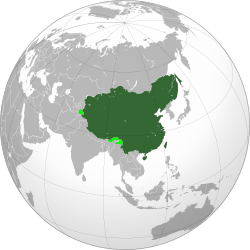Qing dynasty
Qing Dynasty Thanh triều | |
|---|---|
| 1636–1912 | |
| Anthem: Củng kim âu Gǒng Jīn'ōu "Cup of Solid Gold" (1911–1912) | |
 The Qing dynasty at its greatest extent in 1760 superimposed on a modern world map. Territory under its control shown in dark green; territory claimed but not under its control shown in light green. | |
| Capital | Mukden(1636–1644) Beijing(1644–1912) |
| Official languages | Manchu,Mandarin Chinese |
| Religion | Chinese Buddhism,Confucianism,Taoism,Tibetan Buddhism,Chinese folk religion |
| Demonym(s) | Chinese |
| Government | Absolute monarchy[a] |
| Emperor | |
• 1636–1643 (founder) | Chongde Emperor |
• 1643–1661 (first in Beijing) | Shunzhi Emperor |
• 1908–1912 (last) | Xuantong Emperor |
| Regent | |
• 1643–1650 | Dorgon,Prince Rui |
• 1908–1911 | Zaifeng,Prince Chun |
| Prime Minister | |
• 1911 | Yikuang,Prince Qing |
• 1911–1912 | Yuan Shikai |
| Area | |
• Total | 13.400000 km2(5.173769 sq mi) |
| Today part of | People's Republic of China,Mongolia |

TheQing Dynastyor theQing Empire(Chinese:Thanh triều;pinyin:Qīng cháo) was adynastyof rulers ofChinafrom 1644 to 1912. The dynasty was founded by theManchusand so its other name is theManchu dynasty.The surname of the Qing emperors wasAisin Gioro.It became theRepublic of Chinain 1912 after the1911 Xinhai Revolution.
Rise of the Manchu state[change|change source]
In 1580,Nurhacibecame theJian Zhougeneral of theMing dynasty.He unified the Manchu tribe and organised theEight Banners.In 1616, Nurhaci declared himselfKhan(King) and founded theJin dynastyinLiao Ling.In 1626, Nurhaci led armies to attackNing Yuan.Unluckily, Nurhaci was wounded byYuan Chonghuan's Portuguese cannon and he died 2 days later.Huang Taiji,the son of Nurhaci, then succeeded to the throne and became the Khan of the Manchu tribe. In 1643, Huang Taiji was dead, caused byapoplexy.Shunzhi Emperorinherited Huang Taiji's throne.Prince Dorgonbecame the regent. In 1644, the Manchu armies conquered the north of China. The capital was changed toBeijing.The Ming dynasty was overthrown, though fighting continued until 1683.
History[change|change source]
Restoration[change|change source]
A. The self-strengthening movement (1861 - 1895)[change|change source]

The self-strengthening movement(Chinese:Dương vụ vận độngorTự cường vận động;1861 - 1895) was a reform organised during the late Qing. With the defeat in theOpium Warsand the outbreak ofTaiping Rebellion,the emperor and the imperial officials realised that it was necessary to improve the country's state with a series of reforms. Therefore, the Self-Strengthening Movement was started.
The movement could be divided into three phases: the first phase (1861 - 1872), the second phase (1872 - 1885) and the third phase (1885 - 1895). The major leaders areYixin,Prince Gong (Chinese: Cung thân vương ),Wenxiang(Chinese: Văn tường ),Zeng Guofan(Chinese: Tằng quốc phiên ),Li Hongzhang(Chinese: Lý hồng chương ),Zuo Zongtang(Chinese: Tả tông đường ),Shen Baozhen(Chinese: Thẩm bảo trinh ) andZhang Zhidong(Chinese: Trương chi động ). However, owing to the conservatives opposition and the problems ofmodernization,it failed finally.
Reforms were:
- National defence
- Arsenals were built inShanghaiandXiamen.
- Shipyards were built inFuzhouandTianjin.
- TheBeiyang Fleetwas organized byLi Hongzhang.
- Industry and trade
- Modern banks were built.
- Many industries were built in the South of China.
- Diplomatic modernization
- TheZongli Yamen,a foreign office of the Qing dynasty, was set up in 1861.
- In 1868, the Qing government sent its first official diplomatic mission aboard.
B. The hundred days' reform (1898)[change|change source]

With the failure of the Self-Strengthening Movenment, the defeat in theFirst Sino-Japanese Warand thescramble for concessions,many Chinese leaders realised that reforms were urgently needed. Thus, the Hundred Day's Reform (Chinese: Mậu tuất biến pháp; 11 June 1898 - 21 September 1898) was started in 1898. The leaders of the reform wereGuangxu Emperor,Kang Youwei(Chinese: Khang hữu vi ) andLiang Qichao(Chinese: Lương khải siêu ). Eventually, it ended in acoup d'étatled byEmpress Dowager Cixi.
The main reforms were:
- Political reforms
- Useless government posts were to be abolished.
Qing government and society[change|change source]
Politics[change|change source]
TheManchuschanged their ways to be more like theChinesein order to rule them better. The Manchus started wearing Chineseclothesand writing in Chinese. They began to enjoy Chinesefoodandart.One of the Manchu emperors,Qianlong Emperor,began to worry about how much like the Chinese the Manchus were becoming and he tried to get Manchus to be more Manchu. Qianlong Emperor made Manchus ride horses and shootbowsandarrowsso that they would remember where they came from. The Chinese people used different types of clothes like maccukau, konaha, schinin and sakahn.
Regional Development[change|change source]
- Guangdong
In the early Qing,Guangdongwas aprovince.There were 79 counties. In 1911, it was checked that there were 5,041,780 households, approximately 28,001,564 people. The famous mountains in Guangdong wereLingchau,HuanglingandLuofu.Dongjiang,BeijiangandXijiangwere the most important rivers in Guangdong.Guangzhou,Zhaoqing,XiamenandFujianwere the major Guangdong cities.
Further reading[change|change source]
- History of Ming,compiled underZhang Tingyuin 1739.
- Draft History of Qing,compiled underZhao Erxunin 1927.
Related pages[change|change source]
- ↑Briefly aconstitutional monarchyfollowing the onset of the Xinhai Revolution in 1911.



